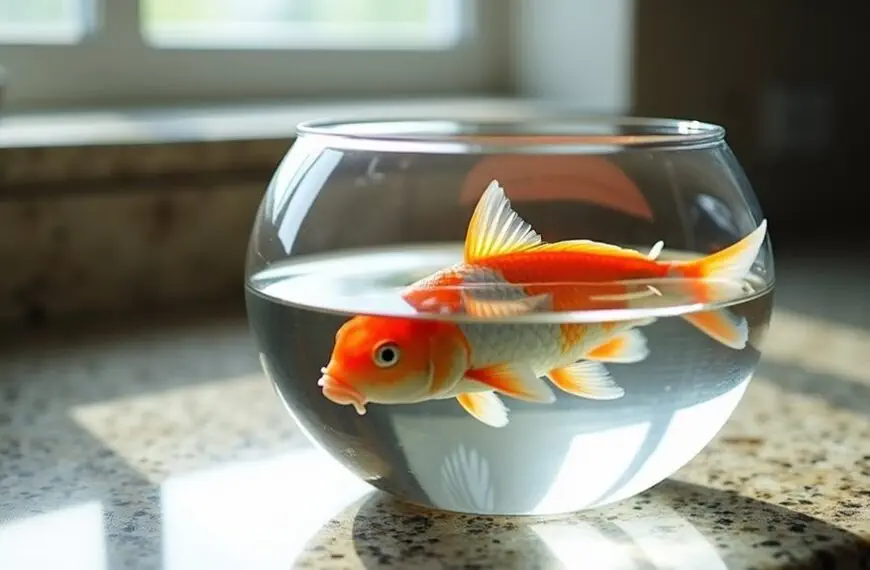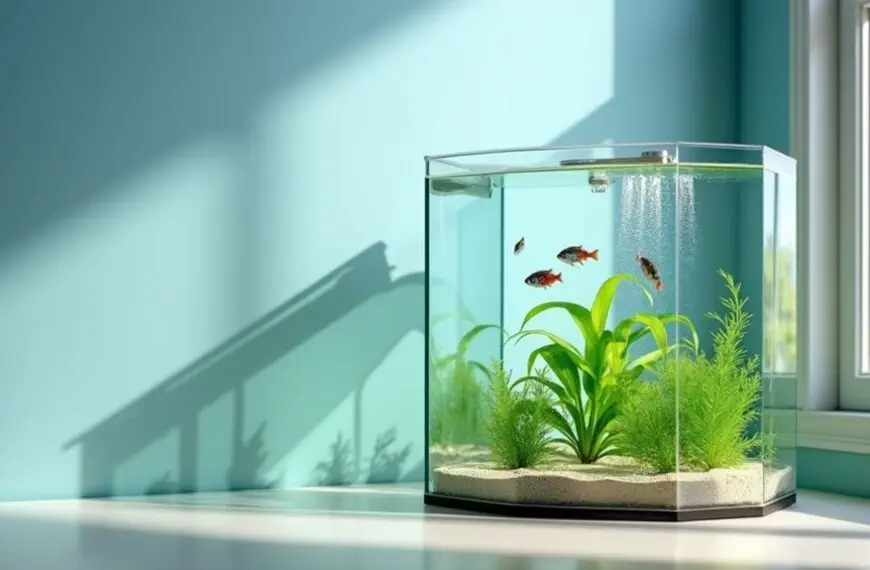While some fish can survive without traditional filters, you'll have better success with hardy species like Bettas, Guppies, and White Cloud Mountain Minnows in a properly maintained tank. These fish naturally adapt to filterless environments when you provide them with plenty of live plants, regular water changes, and appropriate tank sizes – at least 10 gallons for most species. You'll need to maintain stable temperatures (72-82°F depending on species) and keep stocking levels low, about one-third of the usual "inch per gallon" rule. There's much more to creating a healthy filterless aquarium than just skipping the filter equipment.
Contents
- 1 Understanding Fish Without Filters
- 2 Best Low-Maintenance Fish Species
- 3 The Science Behind Filterless Tanks
- 4 Natural Filtration Methods
- 5 Tank Setup Requirements
- 6 Water Quality Management
- 7 Common Myths About Filterless Tanks
- 8 Essential Care Guidelines
- 9 Plant Selection For Filterless Aquariums
- 10 Stocking Density Considerations
- 11 Frequently Asked Questions
- 11.1 How Long Can Fish Survive if the Power Goes Out?
- 11.2 Can Filterless Tanks Be Safely Placed in Direct Sunlight?
- 11.3 Do LED Aquarium Lights Affect Water Quality Without Filters?
- 11.4 Which Fish Diseases Are More Common in Tanks Without Filters?
- 11.5 Should Filterless Tanks Have Air Stones During Winter Months?
- 12 Final Thoughts
Understanding Fish Without Filters
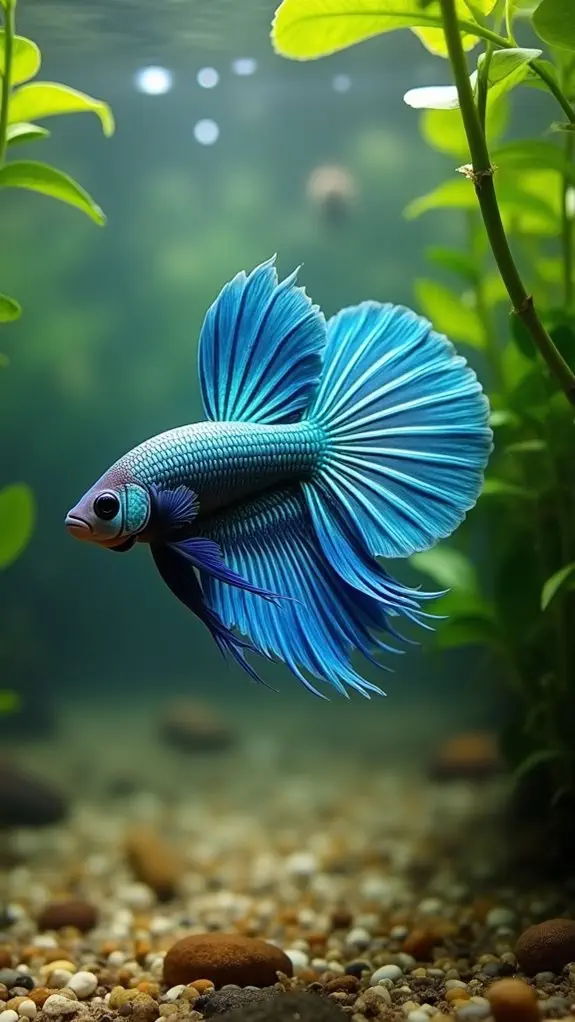
With careful consideration of aquatic ecosystems, keeping fish without filters is possible for certain hardy species.
Small freshwater fish like tetras and danios thrive naturally in streams with minimal filtration.
You'll find that some fish have evolved remarkable adaptations that make them perfect candidates for filter-free living, influencing their fish behavior in fascinating ways. Species like bettas, with their specialized labyrinth organ, can gulp air from the surface, while goldfish have developed an impressive tolerance for varying water conditions. Low-maintenance fish require less frequent maintenance, allowing you to enjoy your aquarium without added stress. Light feeding habits are crucial when maintaining filter-free setups, as overfeeding can quickly deteriorate water quality.
When you're planning a filter-free setup, you'll want to focus on tank aesthetics that combine functionality with natural beauty.
Fast-growing plants aren't just pretty additions – they're working overtime as nature's filters, helping to maintain water quality and provide oxygen.
The Walstad Method, a popular approach for filter-free tanks, creates a self-sustaining ecosystem that mirrors natural habitats.
Think of it as creating your own miniature underwater world where everything works in harmony.
Best Low-Maintenance Fish Species
You'll find several amazing fish species that can thrive without a filter, including popular choices like Bettas, Guppies, and Platies that are perfect for beginners.
These hardy swimmers don't just survive but actually flourish in low-maintenance setups, making them ideal for your first filter-free aquarium. Plus, Platies are considered especially resilient since they prefer hard water and adapt easily to various conditions. Maintaining optimal water quality is essential for their health.
If you're working with limited space, you'll love that many of these species, especially Bettas and Guppies, can live happily in tanks as small as 5 gallons, though they'll certainly appreciate more room to explore. Remember that Bettas require 78-82°F temperatures for optimal health and well-being.
Hardy Fish Species Options
Several hardy fish species stand out as excellent choices for tanks without traditional filtration systems. If you're looking for low maintenance species that can handle less-than-perfect conditions, you'll find some fantastic options that won't make you feel like you're constantly playing aquarium technician.
- Bettas are perfect for beginners, as they're naturally adapted to slow-moving waters and can tolerate various water conditions; they thrive best in a minimum tank size of 5 gallons to ensure proper living conditions.
- Goldfish have earned their reputation as hardy fish, though you'll still need to provide them with adequate space and regular water changes.
- Danios are energetic little swimmers that don't mind cooler temperatures and can thrive with minimal filtration; they can be kept in groups of six or more to promote their natural schooling behavior.
White cloud minnows are excellent candidates since they can thrive in cooler temperatures between 60 to 72 degrees Fahrenheit. When you're setting up your filter-free tank, you'll want to focus on species that have evolved to handle challenging environments. Platy fish and swordtails are particularly resilient choices that won't give you headaches. The peaceful temperament of these species makes them excellent candidates for community tanks.
These hardy fish can adapt to different water parameters, making them ideal for simpler setups. Remember, while these fish are tough, you'll still need to maintain regular water changes and proper tank size requirements to keep them healthy and happy in their new home.
Popular Filter-Free Fish Choices
Building on our understanding of hardy fish species, let's explore specific low-maintenance fish that thrive without filters.
Regular water parameter testing will help ensure your filter-free fish stay healthy and thrive in their environment.
Cherry barbs are perfect additions as they naturally inhabit stagnant waters in the wild, making them well-suited for low-maintenance setups.
If you're looking for excellent fish compatibility and stunning tank aesthetics, you'll love these popular choices that don't need complicated filtration systems.
Bettas are stunning showstoppers that can breathe surface air thanks to their special labyrinth organ. They're perfect for smaller tanks and don't mind living without a filter, as they thrive in peaceful community arrangements.
Guppies, with their vibrant colors and peaceful nature, make fantastic filter-free pets that'll keep your tank lively and interesting.
You can't go wrong with White Cloud Mountain Minnows either – they're incredibly resilient and adapt well to various water conditions.
For a dash of energy in your tank, consider Zebra Danios. They're active swimmers that'll bring life to your aquarium while handling unfiltered conditions like champs.
And don't forget about goldfish – these classic pets are surprisingly adaptable and can manage well without filtration, though they'll need more frequent water changes.
Space Requirements By Species
Space considerations play an important role when selecting filter-free fish for your aquarium. When you're planning your tank setup, you'll need to carefully consider the space requirements for each species to guarantee they'll thrive in their new home.
While some fish can adapt to smaller environments, it's vital to provide adequate swimming room for their health and happiness. Paradise fish require significant space since they can reach up to 4 inches in length. Neon tetras are an excellent choice for smaller tanks, as they do well in temperatures between 70 to 81 degrees and thrive in groups, which enhances their social interactions.
Here's what you need to know about various species' spatial needs:
- Betta fish are perfect for smaller setups, requiring just 5-10 gallons of water, making them an excellent choice for beginners.
- Guppies need at least 10 gallons, but remember they're social creatures that'll need room for their friends.
- Cherry Barbs require more space at 20 gallons, as they love to school together in groups.
When planning your filter-free aquarium, these species considerations should guide your tank size selection.
Keep in mind that while some fish might survive in smaller spaces, they won't truly thrive there. Think of it like living in a tiny apartment versus a comfortable home – your finned friends deserve room to stretch their fins and explore their environment naturally.
The Science Behind Filterless Tanks
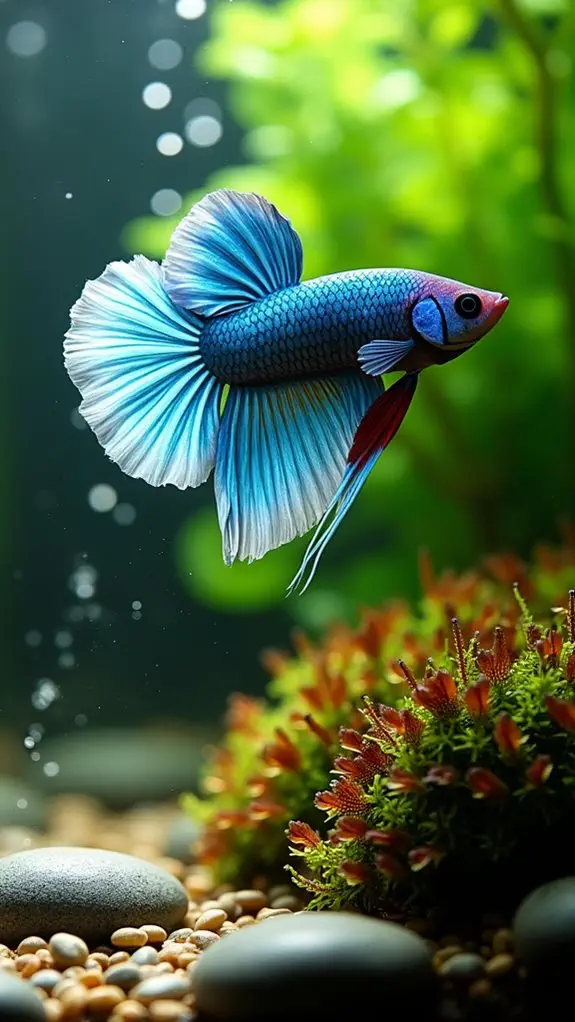
A delicate balance of nature occurs in filterless aquariums, where beneficial bacteria and plants work together to maintain water quality. You'll find that biological balance happens when these microscopic helpers break down fish waste while plants absorb the resulting nutrients. It's like having a tiny cleanup crew working 24/7 in your tank!
The key to success lies in understanding how substrate depth plays an essential role in supporting beneficial bacteria colonies. You'll want to make sure you've got enough substrate to promote healthy bacterial growth, which helps process waste and maintain stable water parameters.
Light stocking is essential too – you can't rush adding fish to your tank, as the ecosystem needs time to establish itself.
What's fascinating is how algae growth, often considered a nuisance, actually contributes to nitrate processing in your filterless setup. Think of it as nature's water purifier! Adding water conditioners can also support the health of your tank's ecosystem by removing harmful chemicals and promoting a thriving environment for fish.
When you're monitoring your tank's ecosystem stability, you'll need to keep an eye on water parameters regularly. With proper planning and patience, you're creating a self-sustaining underwater world that mimics natural habitats – pretty amazing, right?
Natural Filtration Methods
Natural filtration extends beyond just beneficial bacteria and opens up a world of interconnected cleaning methods for your aquarium. When you're setting up a filterless tank, you'll want to create natural ecosystems that mirror what happens in nature. Live plants work tirelessly as your tank's cleanup crew, absorbing harmful compounds while producing oxygen for your fish.
Meanwhile, beneficial microorganisms break down waste and keep your water pristine. To establish a successful natural filtration system, you'll need:
- A generous amount of live plants that cover at least 50% of your tank
- Proper water circulation to distribute nutrients evenly
- A balanced fish-to-plant ratio to prevent overloading
You don't need fancy equipment to maintain crystal-clear water – nature's got your back! The key is creating a balanced environment where plants, beneficial bacteria, and other microorganisms work together harmoniously. In fact, regular monitoring of pH values and dissolved oxygen levels will also support your natural filtration efforts.
Think of it as your tank's very own cleaning team, with each member playing their unique role. With adequate plant growth and minimal fish waste, you'll find that natural filtration can be just as effective as mechanical methods, while creating a more authentic habitat for your aquatic friends.
Tank Setup Requirements
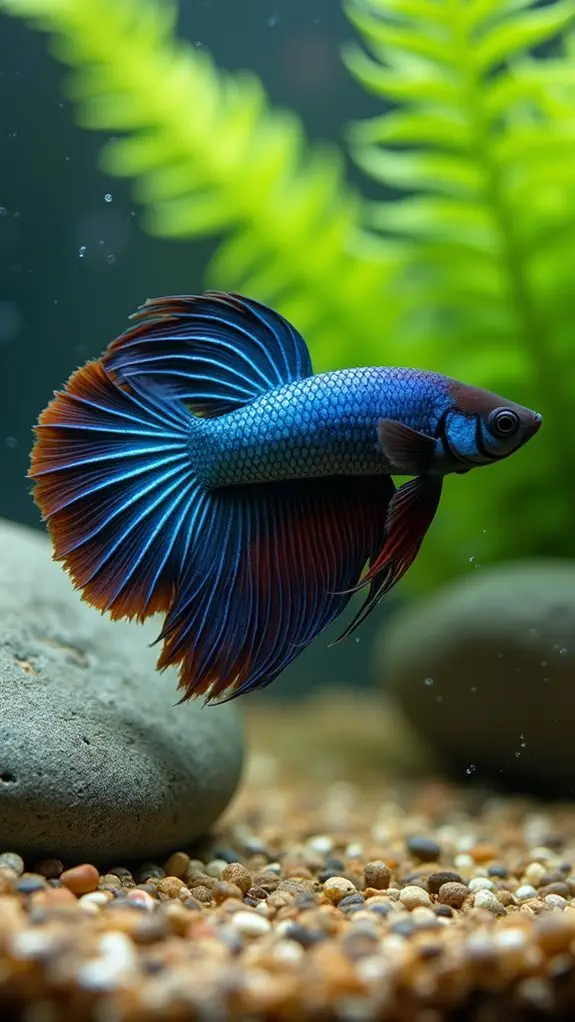
When you're setting up a filterless tank, you'll need at least 10 gallons of water to create a stable environment that won't quickly become polluted.
Your tank must include plenty of live plants like java fern or anacharis, which act as natural filters and oxygen producers while making your fish feel right at home.
You'll want to maintain a consistent temperature between 72-78°F for most common filterless-friendly fish, though some hardy species like White Cloud Mountain Minnows can handle cooler waters. Additionally, the presence of beneficial bacteria is crucial for stabilizing the nitrogen cycle and ensuring clean water.
Essential Water Volume Needs
Setting up the right water volume is essential for a filterless aquarium's success. You'll want to carefully consider both the water volume and tank shape when planning your setup.
A rectangular tank offers the best surface area for oxygen exchange, which is vital when you're not using a filter. While many folks think they can get away with a smaller tank, it's actually easier to maintain stable conditions in a larger water volume of at least 20 gallons.
Here's what you need to keep in mind for proper water volume:
- Leave about an inch of space from the water surface to the tank's rim to prevent overflow and allow for proper gas exchange.
- Account for substrate and decorations, which can reduce your actual water volume by up to 10%.
- Calculate your true water volume by measuring length, width, and height, then adjusting for additions. Additionally, it's crucial to ensure that the size of your tank supports the fish species you choose, as different species have varying requirements.
Live Plant Requirements
Live plants serve as the cornerstone of a successful filterless aquarium system, acting as both natural filters and oxygen producers. When selecting plants, you'll want to focus on hardy, low-light varieties that won't throw a temper tantrum if conditions aren't perfect. Java fern, anubias, and cryptocoryne are your best friends here – they're like the easy-going roommates of the aquatic plant world.
Plant compatibility is essential, so you'll need to arrange your green friends strategically. Place taller plants in the back and shorter ones up front, just like arranging a family photo!
Remember to take into account lighting requirements, as too much light can lead to an algae party you didn't plan for. You don't want to overcrowd the tank either – plants need their personal space, especially at night when they consume oxygen.
For your plants to thrive, you'll need a nutrient-rich substrate that'll keep them well-fed. Think of it as a cozy bed filled with beneficial bacteria that'll help convert fish waste into plant food. Additionally, maintaining optimal water quality is crucial for both plant growth and overall fish health, ensuring a balanced ecosystem.
Regular maintenance, including pruning and water testing, will guarantee your underwater garden stays healthy and vibrant.
Safe Temperature Ranges
Temperature control stands as one of the most critical factors in maintaining a filterless aquarium, as each fish species has its own specific comfort zone.
When you're planning your tank, you'll need to take into account species compatibility carefully, as mixing fish with different temperature needs can lead to stress and health issues. For instance, you wouldn't want to house tropical bettas (who love it warm at 76°-81°F) with coldwater goldfish (who prefer it cooler at 65°-72°F).
To maintain stable temperatures in your filterless setup, you'll need to be extra vigilant about temperature fluctuations, since you won't have the water movement that filters typically provide.
Here's what you should keep in mind:
- Place your tank away from windows and drafts to prevent unwanted temperature swings
- Invest in a reliable thermometer – think of it as your tank's essential signs monitor
- Choose fish species within the same temperature range (tropical, temperate, or coldwater) for ideal compatibility
Water Quality Management
Managing water quality in a filterless aquarium depends on creating a natural balance through multiple complementary methods.
You'll need to master water chemistry and maintain proper algae control through a combination of fast-growing plants like Java fern and Anubias. These plants aren't just pretty additions – they're your natural filtration powerhouse!
To keep your tank healthy, you'll want to establish a strong colony of beneficial bacteria in your substrate. Think of these microscopic helpers as your tank's cleanup crew, converting fish waste into plant food.
Don't forget about regular water changes – they're your best friend in maintaining crystal-clear conditions. Even without a filter, you can achieve excellent water quality by not overcrowding your tank.
Keep a close eye on those water parameters by regularly testing for ammonia, pH, and other essential measurements. It's like being a detective – you're looking for clues that tell you how your aquatic ecosystem is doing.
Common Myths About Filterless Tanks
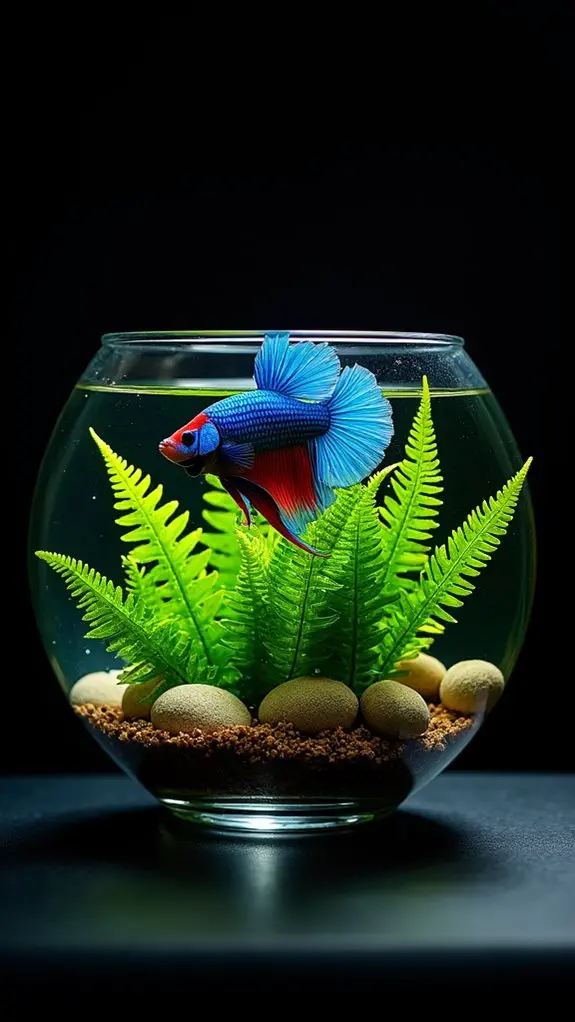
While you've probably heard that some fish don't need filters, the truth is that most fish actually thrive best with proper filtration to maintain healthy water conditions.
Those tiny fish bowls you see in movies aren't ideal setups, as fish need stable water parameters and oxygen levels that natural filtration alone can't always provide.
You'll find that many so-called "filterless" solutions, like relying solely on plants or frequent water changes, don't match the consistency and reliability of a proper filtration system for long-term fish health.
Fish Actually Need Filters
Despite what you might've heard, all fish need filters to thrive in captivity. When you're setting up an aquarium, a filter isn't just another accessory – it's as essential as the water itself! Your fish depend on proper filtration for their survival, and the filter benefits extend far beyond just keeping the water clear.
Think of it as your tank's life support system, working 24/7 to maintain peak water quality.
- Filters act as the "heart" of your aquarium, keeping water moving and oxygen flowing.
- They remove harmful toxins like ammonia that can quickly build up and harm your fish.
- Beneficial bacteria in your filter convert dangerous waste products into less harmful substances.
You wouldn't want to live in a room without fresh air, and your fish don't want to swim in stagnant water. While some species might survive temporarily without filtration, they won't thrive.
Even the hardiest fish, like bettas and goldfish, need clean, filtered water to stay healthy and active. When you provide proper filtration, you're not just maintaining water clarity – you're creating a sustainable environment where your aquatic friends can flourish.
Truth About Bowl Setups
Many fish owners believe bowl setups offer a simple, low-maintenance solution for keeping fish – but this couldn't be further from the truth. In reality, maintaining a fish bowl requires more expertise and attention than a standard aquarium, and you'll face several challenges that can make it tough to keep your finned friends healthy.
Bowl stability is one of the biggest hurdles you'll encounter. Those cute little containers are actually less stable than larger tanks, making it tricky to maintain consistent water conditions.
You're also fighting an uphill battle with oxygen levels, since bowls have a limited surface area for gas exchange. If you fill the bowl completely, you'll restrict oxygen flow, but keeping it half-full leaves your fish with precious little swimming space.
Don't let the small size fool you – these setups need more maintenance, not less. The oddly shaped containers make it difficult to install proper filtration, and standard equipment often won't fit.
While it might be tempting to start with a bowl, you'll likely find yourself upgrading to a conventional aquarium once you realize how challenging bowl maintenance can be.
Natural Filtration Misconceptions
The allure of natural filtration has led countless aquarists down a problematic path. While you might think that letting nature take its course is the best approach, relying solely on natural filtration can create more challenges than solutions.
You'll need to understand that biological balance isn't something that happens automatically – it requires careful management and consistent monitoring.
Here's what you should know about filterless setups:
- They're not actually low-maintenance – you'll need to perform more frequent water changes
- Natural bacteria colonies take longer to establish and are less stable
- Water parameters can swing dramatically without proper filtration support
Don't fall for the myth that plants and bacteria alone will keep your tank clean. Your aquatic friends need more than just nature's helping hand, especially in enclosed environments.
While some fish can survive in filterless setups, they won't necessarily thrive. You'll need to invest significant time in maintenance, testing, and monitoring to maintain proper water quality.
If you're considering a filterless tank, remember that what looks simple on the surface often requires more work behind the scenes to maintain healthy conditions.
Essential Care Guidelines
Maintaining a filter-free aquarium requires diligent attention to essential care practices that compensate for the absence of mechanical filtration. You'll need to perform water changes more frequently, typically changing about 20% of the water every one to two weeks.
While it might seem like extra work, think of it as giving your fish a fresh, clean home that they'll thank you for with their vibrant activity.
Nutrient management plays a vital role in keeping your tank healthy. You'll want to use nutrient-rich substrates and incorporate floating plants, which are like nature's own filtration system.
They'll help control algae growth while adding a beautiful touch to your aquarium. Don't forget to regularly test your water parameters – it's like giving your tank a quick health checkup!
For the best results, you'll need to stay on top of maintenance tasks. Keep an eye on your fish's behavior, vacuum the gravel regularly, and guarantee your plants receive proper lighting.
Plant Selection For Filterless Aquariums
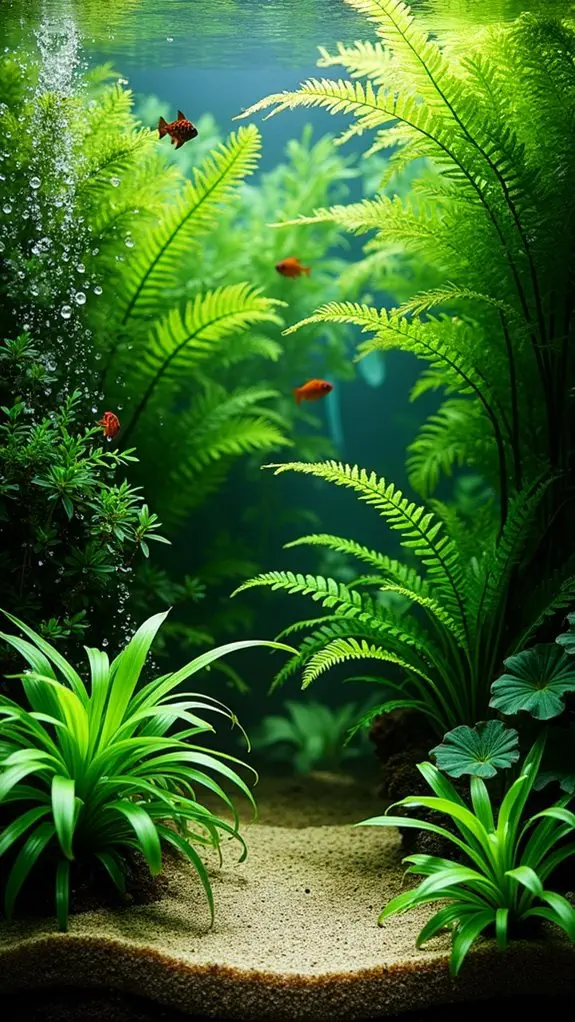
Selecting the right plants serves as a natural filtration system in filterless aquariums. When considering plant compatibility, you'll want to focus on species that can thrive in low-light conditions and adapt to various water parameters.
Plants like java fern, anubias, and cryptocoryne wendtii are perfect choices for beginners, as they're incredibly forgiving and won't throw a fit if you forget to turn the lights on one day!
Your substrate choices play an essential role in supporting healthy plant growth. Whether you opt for specialized planting substrates or use root tabs, ensuring your plants have access to proper nutrients is key to their success.
Here are some plant-keeping tips that'll make your life easier:
- Choose slow-growing plants like anubias and java fern to minimize maintenance
- Create a dense plantation to help absorb excess nutrients from fish waste
- Mix floating plants like duckweed with rooted ones for better water quality
Remember to keep an eye on your plant-to-water ratio and don't go overboard with planting – yes, there's such thing as too much of a good thing!
Regular pruning and monitoring will help maintain a healthy balance in your filterless aquarium ecosystem.
Stocking Density Considerations
Now that you've established a strong plant foundation, it's time to focus on how many fish your filterless aquarium can safely support. When it comes to stocking density in a setup without mechanical filtration, you'll need to be extra conservative with your numbers to maintain water quality and fish compatibility.
Unlike standard aquariums where you might follow the "inch per gallon" rule, filterless tanks require a much lighter stocking approach – think roughly one-third of what you'd normally stock. You'll want to leave plenty of swimming space for your fish while ensuring your plants can handle the bioload.
Remember, those cute little fish at the store won't stay tiny forever, so always plan for their adult size!
Keep a close eye out for signs of tank overstocking, such as fish gasping at the surface or frequent algae blooms. It's better to start with just a few hardy fish and gradually add more once you're confident your ecosystem is stable.
Think of your filterless tank as a delicate balance – like a tiny underwater dance where every participant needs their own space to groove comfortably.
Frequently Asked Questions
How Long Can Fish Survive if the Power Goes Out?
You'll find your fish survival strategies during power outages depend on tank conditions. Most fish can last up to 36 hours, but you'll need power outage preparedness to maintain water quality and temperature.
Can Filterless Tanks Be Safely Placed in Direct Sunlight?
You shouldn't place filterless tanks in direct sunlight. It can cause tank temperature spikes and excessive algae growth. If you must, monitor closely and use fast-growing plants to compete with algae for nutrients.
Do LED Aquarium Lights Affect Water Quality Without Filters?
Your LED aquarium lights won't directly impact water quality without filters. However, they can influence plant growth and algae development, which affects water conditions. Proper LED lighting schedules help maintain a balanced aquatic environment.
Which Fish Diseases Are More Common in Tanks Without Filters?
You'll find common fish diseases like ich, ammonia poisoning, and columnaris more frequently in unfiltered tanks. Without proper tank maintenance, your fish can suffer from these conditions due to poor water quality.
Should Filterless Tanks Have Air Stones During Winter Months?
You'll want air stones during winter months for heavily stocked tanks, but they're often optional in lightly stocked setups. Consider your tank's oxygen needs and monitor fish behavior for signs of oxygen deficiency during winter care.
Final Thoughts
You've now got all the tools you need to create a successful filterless aquarium! Remember that while certain fish can thrive without mechanical filtration, you'll still need to maintain proper water quality through natural methods. Whether you choose bettas, guppies, or paradise fish, you're ready to start your low-maintenance aquatic journey. Just keep up with water changes, stock wisely, and let nature do its filtering magic for a beautiful, healthy tank.


